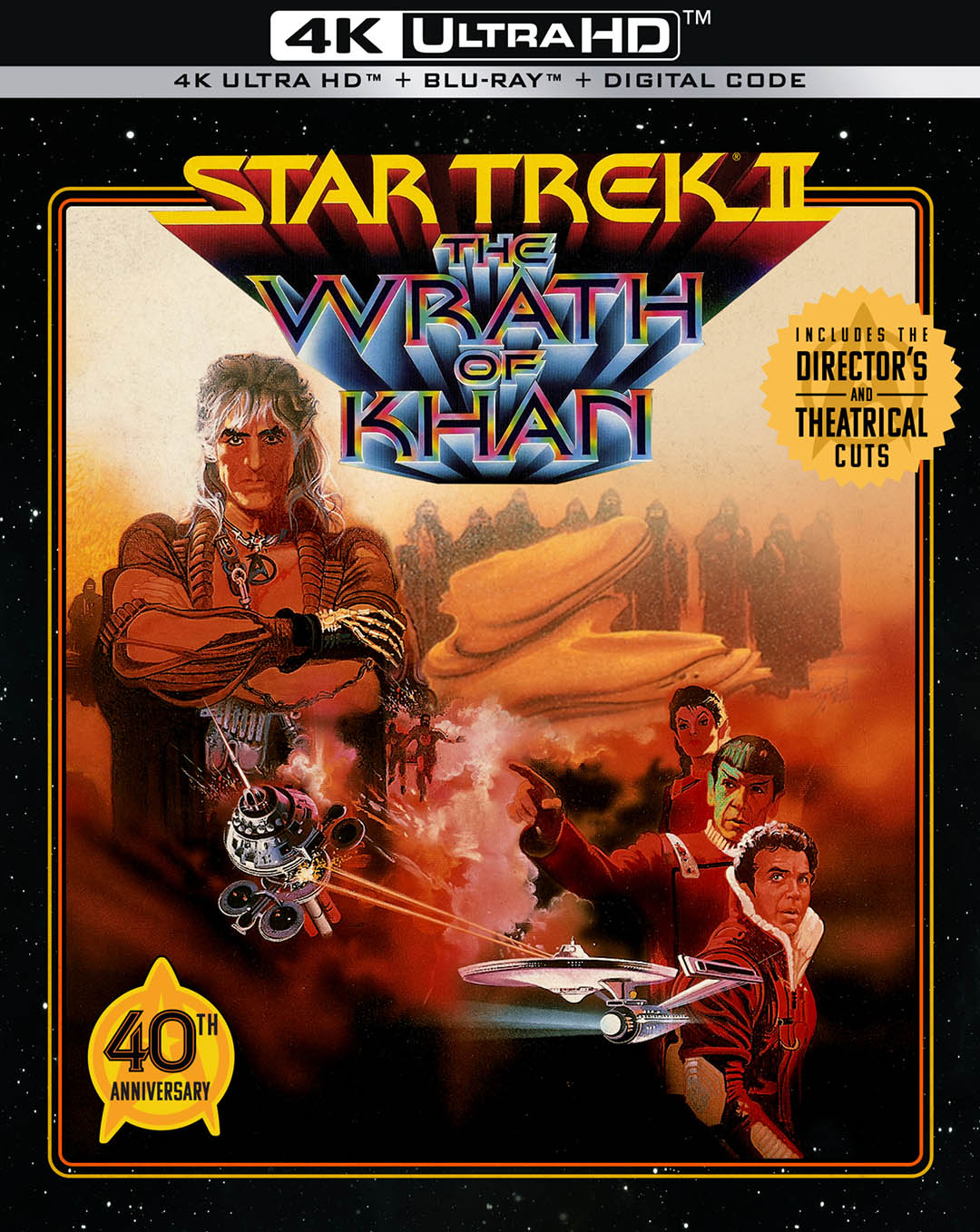
Star Trek: The Wrath of Khan (1982) was released to 4k Blu-ray Disc for the first time as part of the Star Trek The Original 4-Movie Collection (pictured below) on September 7, 2021. A year later, the film was released as a standalone 4k Blu-ray edition on September 6, 2022, to celebrate its 40th Anniversary. The 2-disc edition from Paramount Home Media includes a 4k Blu-ray, Blu-ray, and Digital Code with both the Director’s and Theatrical Cuts.
For the Original 4-Movie Collection, each Star Trek movie was remastered with HDR from original film elements for the 4k presentation, and the audio is provided in a Dolby TrueHD mix with up to 7.1 channels. The 6-disc set also includes 3 upgraded Blu-ray Discs from the new film restorations, as well as Digital Copies redeemable on iTunes or Vudu. The most popular film from the original four, ‘The Wrath of Khan’ is presented in both the Theatrical and Director’s Cut versions.
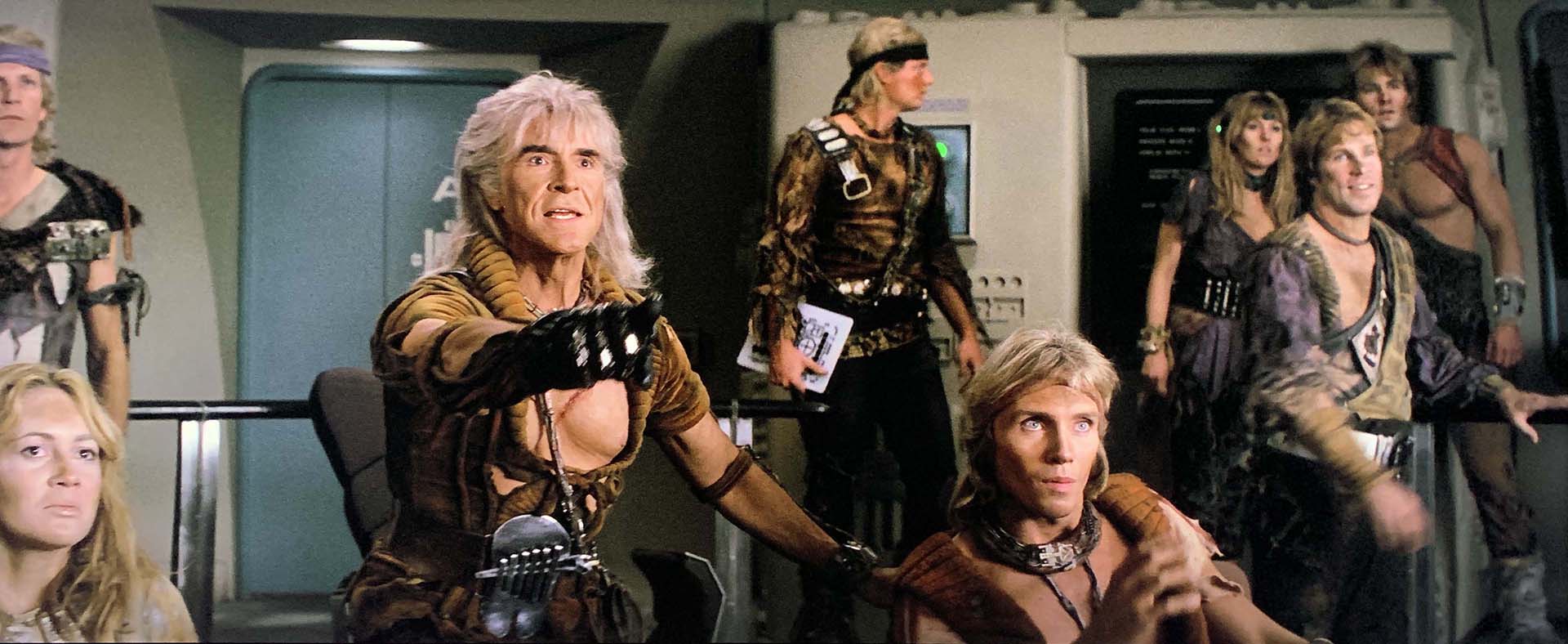
The Movie
The introduction to ‘The Wrath of Khan,’ like other Star Trek movies, starts with an extensive 3-minute musical composition while the movie credits roll. It may seem tedious and maybe even boring in this day and age but you can’t help but feel emotional about the idea of space travel, even if pretending, during the next two hours of movie watching.
The opening scene to ‘The Wrath of Khan’ starts with the Kobayashi Maru test exercise for Sarik (played by Kirstie Alley) which she fails miserably as the commander of the Enterprise. Later, we learn about Captain Kirk’s infamous outsmarting of the Kobayashi Maru test in which he rewrites the parameters in order to win. The story is later expressed in more detail in J.J. Abrams’ Star Trek from 2009.
It’s a common filmmaking strategy to start with an explosive scene, even if it isn’t real, to grab the audience’s attention. In ‘The Wrath of Khan’ there are actual explosions on the bridge in which crewmembers including Chekov, McCoy, Spock, Sulu, and Uhura are thrown aside by the force. Why a test exercise would include real explosions and why the crew is acting as if deceased is a discussion for another time. (Unless the entire scene took place in a Holodeck, even though that technology was not explored until later Star Trek episodes and movies.) Nevertheless, mini-explosions on the deck of the Enterprise and other starships is one of the trademark Star Trek effects that is even used in the reboot movies from J.J. Abrams.
There are lots of retro topics to talk about with a film of this age, especially in a sci-fi movie that supposedly predicts the future of technology. Heck, we are actually using what Gene Rodenberry fantasized about in terms of communications back in the 60s — video calls on handheld devices in which you can see others in realtime. We also have handheld devices that can scan for illness and disease. We just haven’t invented transporter technology yet.

What’s funny about these older sci-fi movies is that they used analog disruptive video signals instead of what we know today as digital (or pixelated) interference. So, when there’s a problem with video communications the image looks like an old snowy analog TV (as seen in ‘The Wrath of Khan’s’ contemporary Poltergeist and other horror films), rather than the digital signals we know today.
Going further with the horror connection, the scene on Regula 1 (where the Genesis laboratory is housed) is reminiscent of Alien films and other sci-fi horror films in which another lifeform invades the human body. The horror of the “ear creatures” is not something we saw in Star Trek: The Motion Picture and may be one reason why ‘The Wrath of Khan’ is clearly a fan-favorite among the first four original films.
One could go on and on about ‘The Wrath of Khan’ in terms of filmmaking and how it relates and borrows from other films that were its contemporaries. And, much can be discussed about how this movie fits into the Star Trek universe. But we’re here to talk about the home theater presentation of the movie for the first time in 4k Ultra HD.
Equipment
Star Trek: The Wrath of Khan on 4k Blu-ray was reviewed on a 75” Sony Bravia LED 4k HDR TV with a Sony HT-ST5000 soundbar that supports Dolby Atmos audio. The disc player is the Sony UBP-X800M2 with support for Dolby Vision, HDR10, and HLG HDR formats.
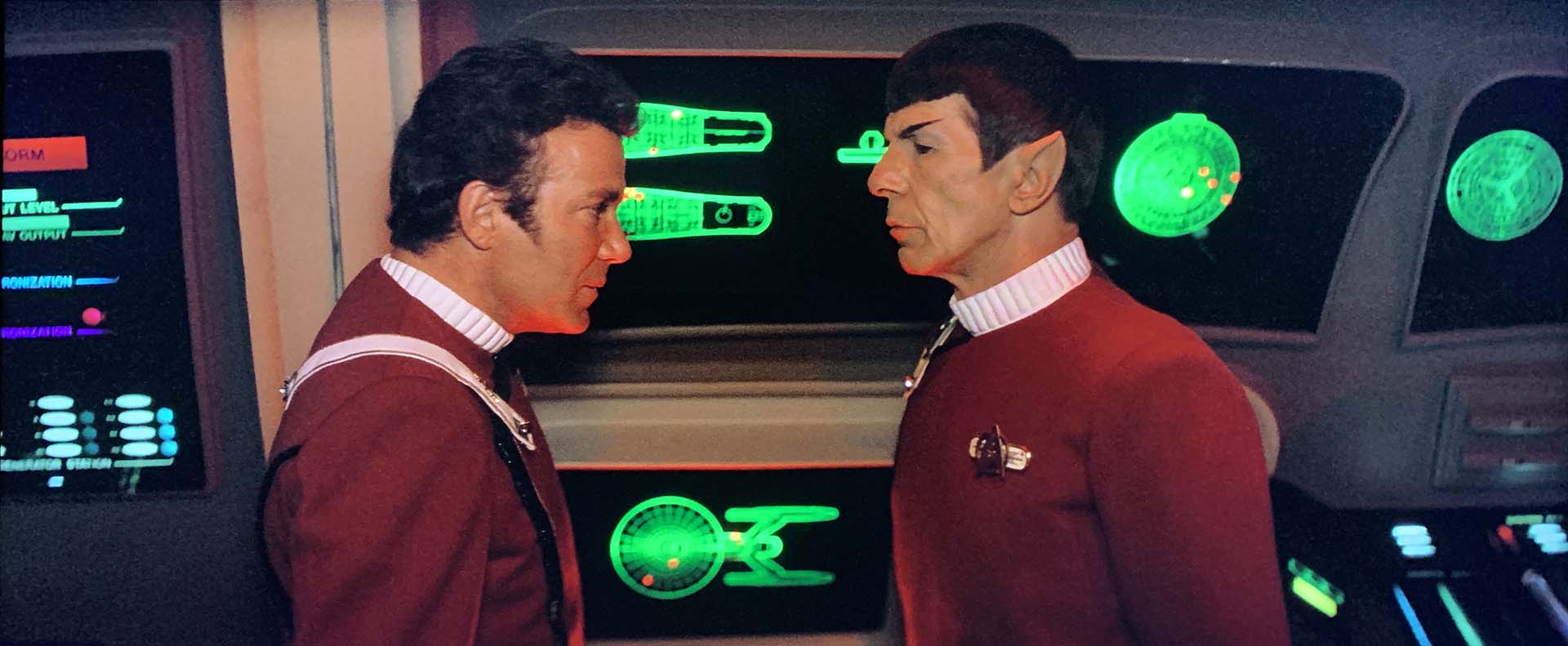
Video
‘The Wrath of Khan’ is presented in 4K (2160p resolution) at 24 frames per second with Dolby Vision HDR and the BT.2020 color spec that enables up to 10 bits of color on 4K Blu-ray discs. The color depth improvements give this film an extra punch beyond what the 4k video resolution brings. Much of the disc content played at about 45 to 50 Mbps, jumping into the 60Mbps range on occasion.
At 48 minutes, when the Reliant attacks the enterprise and leaves it only with auxiliary power, the colors are saturated and vibrant. The red lighting on the bridge of the Enterprise during an alert status (a tradition in Star Trek battle scenes) looks great in HDR contrasting the blue aqua color of the panel lights in the background. On a 4K HDR TV playing a 4K Blu-ray disc, the displays that the crewmembers work on are extremely detailed — like never before.
What would a Star Trek film be without a docking sequence? At 36 minutes we have another scene in which crew members are taxied over to the Enterprise. In ‘The Motion Picture’ the docking seemed like an eternity as Kirk and Scotty taxi along the outside of the Enterprise. The video quality and sharpness of the image is good, although there are notable black outlines surrounding the superimposed ships and astronauts.
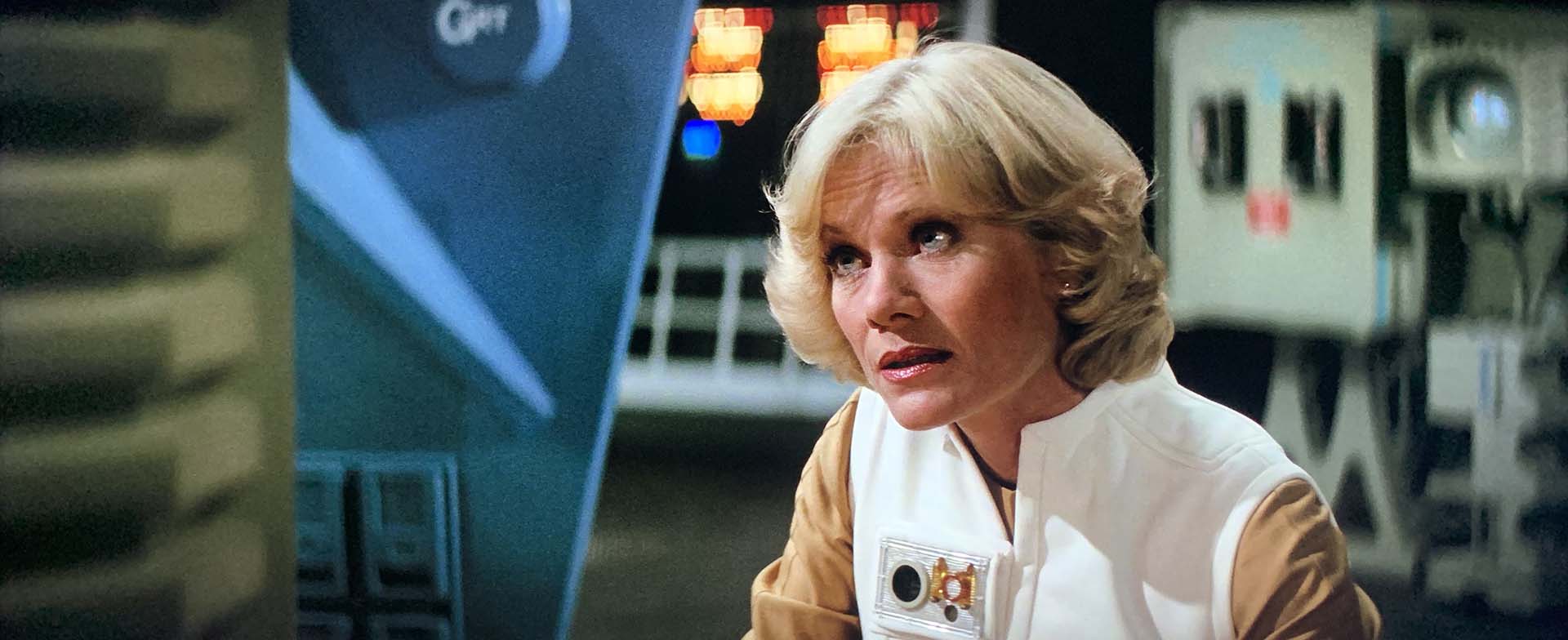
The set designs only got better and better as Star Trek films evolved. A set that’s definitely worth looking at in detail is the Regula 1 lab (at 13:00 and 57:30). The space station Regula 1 lab looks incredibly colorful and sharp with a nice depth to the structure. The fact the production quality still holds up today is a testament to the movie crew who built the sets and models. There is good detail to both the exterior and interior of many ships in ‘The Wrath of Khan.”
A real nice detail can be found in the scenes on Regula 1 when the video images of Chekov and Uhura are shown through small monitors. Uhura, in particular, looks amazing in the small screens placed around the lab. The detail in the set design is also very apparent in 4K. For example, in one scene you can read the words “JBK SENSORS SYNTHOSTASIS” in very legible letters behind the video of her. This is around time code 1:00:00 when Kirk, Spock, and Sarik board the Regula 1. Text is generally sharp in all of the scenes in this higher-resolution print.
The colors in the Mutara Nebula at 1:22:00 are extraordinary. It’s a signature of Star Trek films to have sweeping celestial backdrops to the Enterprise that represent spatial environments, both known and unknown, that exist beyond Earth. On an HDR TV the colors are expressed substantially more than without HDR and certainly miles beyond what a typical computer screen could deliver.
One of the most memorable scenes in this movie and in the entire Star Trek archive is when Dr. Marcus introduces Kirk to the Genesis creation. This is at one hour and 18 minutes. The music is so fitting for the moment but the image (a painted scene of a freshly created paradise with lush forest and flowing waterfalls) does not hold up so well on a big screen in 4K.
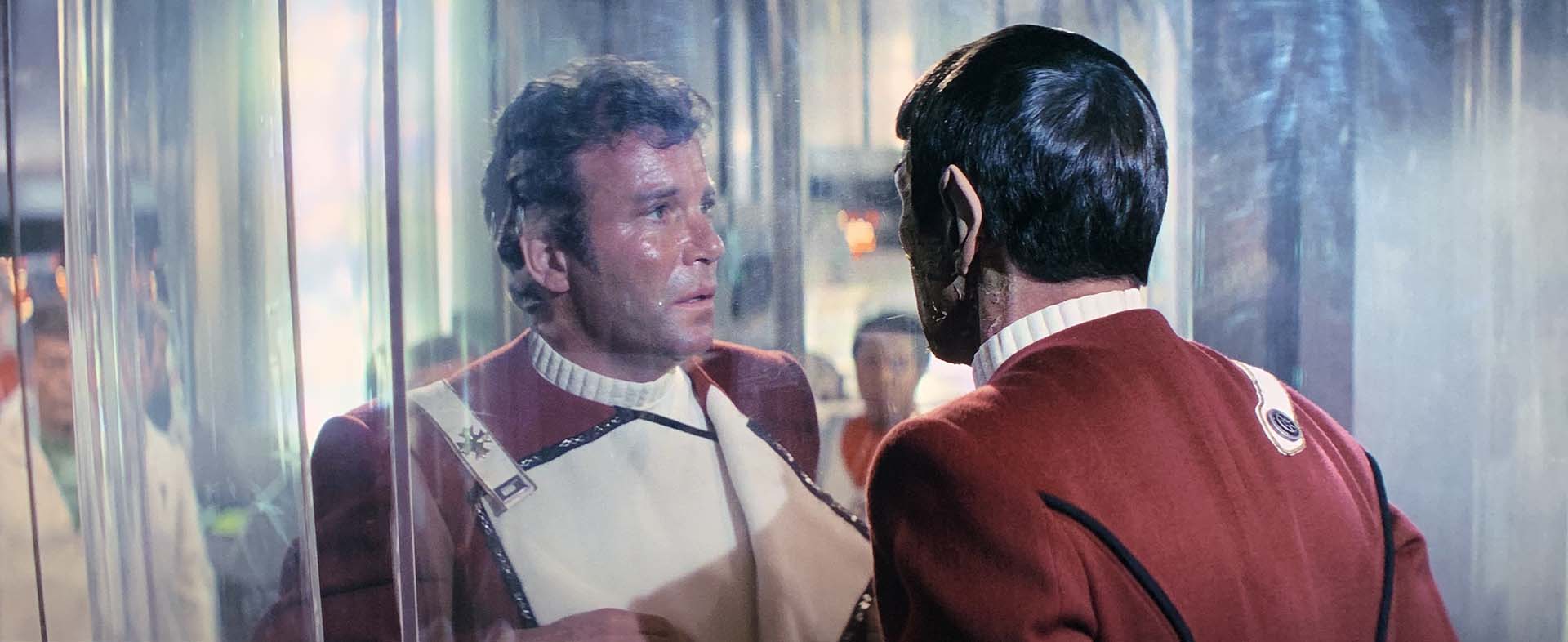
Audio
The four movies in the collection all play in English 7.1 Dolby TrueHD with options in French in 2.0 Dolby Digital and the isolated score in 2.0 Dolby Digital. Audio streamed at about 2.8 to 3 Mb per second and 48 kHz Dolby TrueHD with up to 7.1 channels. Audio is offered in several languages including English, Spanish, French and Japanese.
What’s great about the audio in these new presentations are all the noises from the starships that seem to surround and envelop you in the spaceship itself.
There’s a nice distant thunder in the Mutara Nebula around 1:22:00 that could have been exaggerated in its low-frequency range but nevertheless, it’s nice hearing the thunder sitting in the background as if from a distance.
What’s always been great about the soundtrack to Star Trek movies and other sci-fi movies is the music composition that changes according to the imagery. In ‘The Wrath of Khan,” for example, the sweeping orchestra sounds from composer James Horner change when they move to the enemy in this case Khan, just by adding strings or other types of instruments. Without even seeing the video image, you can usually tell what is happening in a Star Trek movie just by the music composition and sound design.
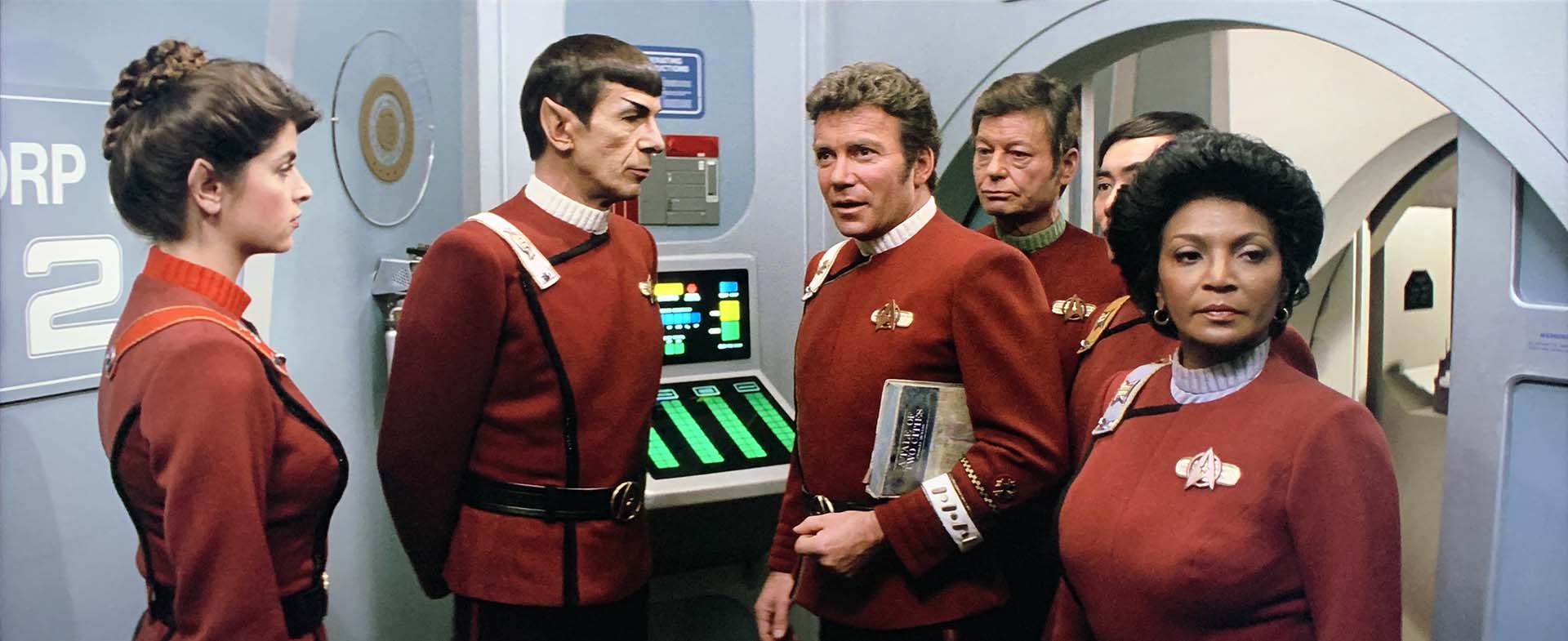
Bonus Material
Extras included with Star Trek: The Wrath of Khan (1982) on 4k Blu-ray include commentary by Director Nicholas Meyer on both the Director’s Cut and Theatrical Version, original interviews with William Shatner, Leonard Nimoy, DeForest Kelley, and Ricardo Montalbán, and Collecting Star Trek’s Movie Relics in The Star Trek Universe bonus, among others. The extras are detailed below.
Special Features
- Commentary by Director Nicholas Meyer (Director’s Cut and Theatrical Version)
- Commentary by Director Nicholas Meyer and Manny Coto (Theatrical Version)
- Text Commentary by Michael and Denise Okuda (Director’s Cut)
- Library Computer (HD)
- Production
- Captain’s Log
- Designing Khan
- Original Interviews with William Shatner, Leonard Nimoy, DeForest Kelley, and Ricardo Montalbán
- Where No Man Has Gone Before: The Visual Effects ofStar Trek II: The Wrath of Khan
- James Horner: Composing Genesis (HD)
- The Star Trek Universe
- Collecting Star Trek’s Movie Relics (HD)
- A Novel Approach
- Starfleet Academy SCISEC Brief 002: Mystery Behind Ceti Alpha VI (HD)
- Farewell
- A Tribute to Ricardo Montalbán (HD)
- Storyboards
- Theatrical Trailer (HD)
Scores
Movie
5/5
Video
4/5
Audio
5/5

Bonus Material
4/5
